Orchidaceae
Maxillaria

Kingdom: Plantae Rank: Genus Parent: Orchidaceae Status: Valid
Morphological Description
Diagnosis: Maxillaria as traditionally defined is extremely variable. Pseudobulbs may be present or absent. The flowers almost always have a well-developed column foot that typically projects downward or backward. The column foot is conspicuous and persistent in fruit. The only similar orchid fruits in the flora are those of Ida and Xylobium. Ida differs by having plicate, rather than conduplicate leaves. Xylobium differs by bearing pedunculate racemes of flowers, rather than solitary flowers on scapes or in fascicles.
Vegetative Morphology
Habit: Extremely diverse epiphytes, lithophytes, and terrestrials, caespitose or trailing, erect or pendent, the plants occasionally massive and shrub-like. Pseudobulbs present or absent, +/- subtending foliaceous bracts, sometimes in combination with erect, non-pseudobulbous stems.
Leaves: Leaves 1--3 and usually petiolate when pseudobulbs are present, highly variable, sometimes needle-like, rarely spotted with cuticular wax, usually numerous and alternate, distichous when pseudobulbs are absent.
Reproductive Morphology
Inflorescence: Inflorescences basal or axillary, single-flowered, sometimes fasciculate, usually covered with bracts, the floral bract prominent, usually concealing the ovary.
Flowers: Flowers solitary or produced in clusters (when basal), long-lasting or rarely ephemeral, usually cupped, highly variable in color. Sepals and petals free, spreading, usually subsimilar, the petals often smaller than the sepals. Lip unlobed or three-lobed, often obscurely lobed, articulate to the column foot, with a central longitudinal callus, the callus often glossy or covered with mealy trichomes. Column straight or slightly arching, the clinandrium often ornamented; pollinia 4, strongly compressed in two pairs, usually sessile on a common large viscidium, but the stipe sometimes conspicuous or long and slender.
Other
Notes: Maxillaria is poorly studied at the species level. Thus several names have been recorded for the flora that represent dubious records. These names and vouchers are repeated here but the following are not included in the key at this time: M. elegantula, M. lilliputana, M. luteoalba, M. nutans.